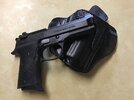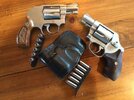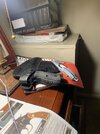Hello – I had an interesting experience at the range yesterday, and as a result, I would like some opinions from THR.
To set the stage for my question: I currently keep a J-frame revolver at home for my home defense gun. I live in a decent neighborhood with low crime, so under the circumstances, it fits the bill.
I chose a revolver at home for the following reasons:
1) It’s repeatable and reliable: If a round fails to go off, I simply pull the trigger again to chamber a new round.
2) It’s low maintenance: It can sit in its assigned place for 10 or 15 years, and I still have confidence that it will work when needed.
3) There’s nothing to think about in a stressful situation (is it loaded, is a round already chambered, etc.) Just point and shoot.
4) The heavier DA trigger pull provides some insurance against an accidental discharge while both under stress and possibly half asleep, depending on the situation.
5) A J-frame fits well in its assigned place.
All my other guns are semiautos (EDC, competition, etc.) I do have a K-frame and L-frame, but I use them only for range toys.
Now here is the rub and the source of my question:
I routinely cycle through my defensive weapons at least once a year, to ensure both functionality and familiarity. Yesterday I went to the range to shoot my J-frame, and when I picked it up for the first time, I was confused on how to hold it. My muscle memory is used to the semi-auto hold (both thumbs forward on frame, right thumb over left thumb, etc.) That of course doesn’t work well with a revolver, so I had to think for a minute and adjust my hold.
That got me to thinking and wondering: In a stressful home situation, when reaching for my revolver, it might take me a few seconds to get the right grip on it, delaying any action I might want to take. Not good, and a source of concern to me.
Now my question: Do you think I should go “all in” on semiautos for my defensive purposes, including home, so that I have one grip to use for everything instinctively? I’d save the revolvers for range toys, but otherwise I would be using the same handgun grip for EDC, competition, and home use. That enables my muscle memory to be consistent and avoids any possible confusion in a stressful situation.
I’m not considering any type of rifle or shotgun in this question, so no need to recommend them. It’s strictly between semiauto and revolver in the home. I have another semiauto I can put into my home defense rotation, so this decision won't cost me anything either way.
Any thoughts one way or the other? I realize there is no "right" answer; just looking for some perspectives to help me make a decision.
Thanks





